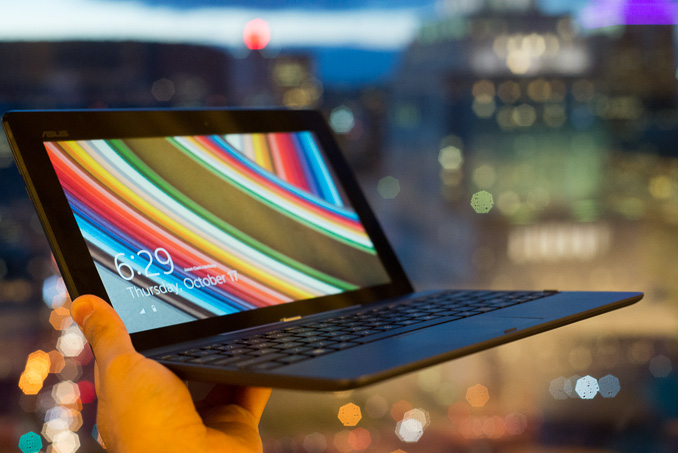ASUS Transformer Book T100 Review: Redefining the Entry-Level Windows Notebook
by Anand Lal Shimpi on October 18, 2013 12:00 AM ESTFinal Words
It’s tough to sell an entry-level Windows PC these days. You’re sandwiched between a couple of aggressive price points: the Nexus 7 at $229 and the iPad at $499. Traditionally, the PC you’d get between those price points would have mechanical storage, the cheapest of cheap TN panels, be bulky as possible, an unimpressive keyboard/trackpad and have 2.4GHz-only WiFi. About the only solace would be that it’d have some insanely quick Core architecture CPU inside, which more or less didn’t matter since the overall experience was hampered so much by the spinning disk inside. Thankfully, times are changing.
Assault first and foremost comes from Google’s latest lineup of Chromebooks. The HP Chromebook 11 addresses many of these concerns but with a fairly limited OS and silicon that’s honestly a bit too slow, even for the target market. But you do get an awesome keyboard, eMMC based storage, and an IPS panel among other things.
The Transformer Book T100 is really the Wintel camp’s answer to the Chromebook onslaught. Compared to the traditional entry-level PCs out there, the T100 really is a breath of fresh air. You get an IPS panel, great battery life and modern WiFi all in a package that can work as both a notebook and a tablet. The system is responsive and predictable in its performance thanks to the use of solid state storage. While there isn’t a full blown SSD inside, the eMMC solution is clearly better for light consumer workloads than a mechanical disk. Solid performance from the rear facing speakers and excellent portability round out the T100’s package. If I had to compare it to what you’d normally expect to get from a $349/$399 Windows PC, I’d say the Transformer Book T100 is a clear winner.
Where things get complicated is if/when you start comparing across platforms. ASUS and Google set the standard for affordable color calibrated displays with the 2013 Nexus 7, and unfortunately the T100 comes no where close to that. Even HP’s Chromebook 11 delivers a more accurate out of box experience than the T100. Again, the T100’s display isn’t bad, it just desperately needs a factory calibration.
It’s important to keep the T100’s performance in perspective. For light multitasking or single app-use workloads, the T100 does very well (much better than the Chromebook 11 we just reviewed). Light browsing and document work are at home on the T100. Don’t expect it to be a Haswell replacement though. I would like to see the gap narrow between Intel’s Atom and Core lines, but I’m afraid it’s going to take real performance pressure from a competitor before we ever see that day.
The dock experience on the T100 is reasonable, but it’s clear to me that the Transformer Book T100 is first and foremost a tablet, and only serves as a clamshell device as a secondary function. That’s not to say it makes for a bad notebook experience, it can just be cramped as a result of the 10.1-inch display footprint. If you’re looking for a device that you’ll use mostly as a tablet but want the flexibility of turning it into a notebook when you need to, the T100 can definitely fit the bill. If your desire is primarily for a touchscreen notebook, then the T100’s tradeoffs may be more frustrating.
At the end of the day the T100 is a good device, but like the Chromebook 11 we recently reviewed it could’ve been amazing with a few tweaks. With a less reflective display, color calibration at the factory and a better feeling keyboard/trackpad I’d be absolutely in love with the T100. I also wonder if 10.1-inches is the right form factor for this sort of a device. I’m not sure that Microsoft’s decision to go with 10.6-inches is the right one either, but the typing experience on a Surface’s type/touch covers does feel remarkably less cramped.
The T100 truly lives up to the Transformer brand. The combination of Intel's Bay Trail silicon and ASUS' mechanicals gives the device a dual personality. In tablet mode it's just as portable as any other 10-inch tablet, while in clamshell mode it can be a netbook-style ultraportable PC. I’d love to see ASUS continue down this path and truly try to perfect the device. I look at the work that ASUS and Google do together and can’t help but wonder what the T100 would look like if it had the same sort of pressure/influence. Perhaps that’s a bigger criticism of how Microsoft works with its partners, but I look at the comparison of ASUS tablets with and without Google’s influence and try to imagine a further polished Transformer Book. That’s something I’d really like to see.
There are very few perfect computing devices out there, but ASUS is one of the companies with the ability to build one if it really tries.












158 Comments
View All Comments
nathanddrews - Friday, October 18, 2013 - link
8+ hour battery life, under 1" thick, under 3lbs, full Windows OS, IPS touchscreen, detachable base for tablet mode, $350. How exactly is that not redefining entry level? I sure as H-E-double hockey sticks haven't seen anything like it.AsusJake - Sunday, October 16, 2016 - link
3 years later I'm still using an asus t100 now with windows 10 64 bit system only 2 gigs of ram and still better than any tablet ive had. only my note 5 that I own has been faster......Drumsticks - Friday, October 18, 2013 - link
"Redefining the Entry Level Windows Notebook" how is it not? Great display, Decent performance without a bad IO system, and amazing battery life. There wasn't a single $350 notebook on the market a year ago that would have given you that.Qwertilot - Friday, October 18, 2013 - link
Running windows anyway ;)Seriously though, this isn't an entry level notebook, its a slightly odd hybrid device. With associated compromises noted in the review. Anyone know if we're going to get normal notebooks with similar specs as well?
Drumsticks - Friday, October 18, 2013 - link
Dell has a haswell Pentium based CPU in an 11" notebook rated for somewhere in between 8-10 hours of battery life for $379. I'm not sure if it has an IPS display though.Krysto - Friday, October 18, 2013 - link
Also, as usual, Intel's Atom can barely keep up with LAST YEAR's ARM chips, in both CPU and GPU performance. Same old story.Guess Silvermont wasn't as revolutionary as you made us think it is with every chance you got - was it, Anand?
Speedfriend - Friday, October 18, 2013 - link
"Intel's Atom can barely keep up with LAST YEAR's ARM chips, in both CPU and GPU"You seem to have problem with reading, The Samsung Note 10.1 has the latest top of the range Samsung big.little quad core with the latest Mali 628 and yet loses out to the Atom in every CPU test. And this isn't even top of the range...
I know some people are biased, but come on...
darkich - Friday, October 18, 2013 - link
..and you say that Note's 1440p doesn't matter?Or the fact that android has shitty JS optimization?
Amazing how you failed to see how an old dual core Exynos on Chromebook outperformed this BT on those SAME CPU tests you bring up!
And you talk about bias!
The fact is Bay Trail is a Meh chip.
Given the superior manufacturing process it fares pretty badly in coparison with ARM, and has about 30-50 % weaker GPU.
Boissez - Friday, October 18, 2013 - link
Wow... I've never seen a device with colors this much out of wack. The beauty of this thing running Windows is that it can be fixed with a color calibrator though. It's a shame about the poor brightness though.Either way the latest batch of Win 8.1 tablets are shaping up nicely. Are there any plans to review any of the smaller 8" tablets like the Dell Venue 8 pro or Lenovo Miix 2?
CSbeer - Friday, October 18, 2013 - link
I bought a win8 tablet on clearance (Iconia W3 for $249) and have to say I'm never going back to IOS or Android. It's even gone so far as replaced my netbook and I only lug around my 15" laptop when I need the extra power for school or work. I just don't get all the win8 hate, it sure has made my life easier.